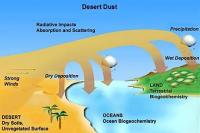- Use environmental data and themes to help your students apply mathematics to real-world problems. Assign environmentally-themed math problems, analyze data such as population figures, land use statistics, and pollutant levels, use data to draw inferences about changes in population and natural resource consumption, and have students explain the impacts of their analysis. Use the search function to the right to explore other ways to use environmental data in your classroom.
- StoryPosted bycgray3onFebruary 1, 2011
The amount of dust in the Earth's atmosphere has doubled over the last century, according to a new study; and the dramatic increase is influencing climate and ecology around the world.
Posted in: - ResourcePosted byAnonymousonMarch 24, 2010
In this lesson, students discover water and energy connections by learning how sources of energy require substantial amounts of water and how energy is used in the process of providing tap water to millions of homes.
Posted in:
Latest in this Subject
View more News, Resources , Professional Development, Grants, Success Stories
- ResourcePosted bycaitlineonJuly 21, 2011
The Water Sourcebooks, developed by the U.S. Environmental Protection Agency, contain 324 interdisciplinary, hands-on activities on topics including Introduction to Water, Drinking Water and Wastewater Treatment, Surface Water Resources, Ground Water Resources, and Wetlands and Coastal Waters.
- ResourcePosted bycaitlineonJuly 21, 2011
Magnificent Groundwater Connection is a series of lesson plans surrounding groundwater from the U.S. Environmental Protection Agency. Lesson plans are appropriate for students in grades 7-12 and can be adapted to meet science and math standards.
View resource - ResourcePosted bycaitlineonJuly 21, 2011
The Fix a Leak Week learning resources are a set of activities designed for students in grades 3 through 5 to help them learn about water supplies and the importance of saving water.
View resource - ResourcePosted bycaitlineonJuly 8, 2011
This CD-ROM is a collection of 41 classroom activities, assembled by educators in the COSDD Great Lakes Project that provides teachers, non-formal educators and students in grades 4-10 with insights into the uniqueness of the Great Lakes and their influence on aquatic life and human populations.
View resource - ResourcePosted bycaitlineonJuly 6, 2011
NOAA's Ocean Service Education website provides educational games, resources, projects and activities for students as well as lesson plans, curricula and professional development for teachers.
Do you know of a resource that you think other teachers should know about?
Share your resource!



